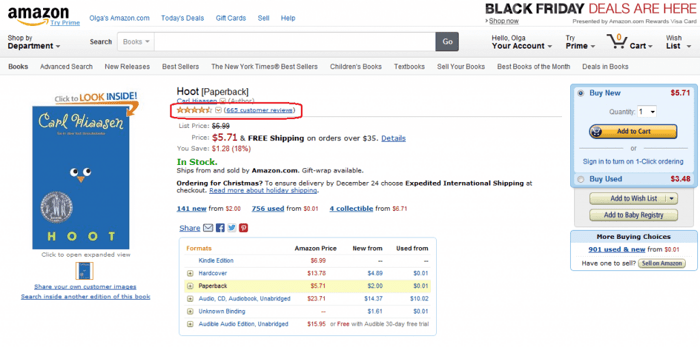7 Ecommerce Brands That Get SEO Right

There are some ecommerce sites we users and the digital world look up to. Amazon, Etsy, Macy's, Overstock are not only go-to places to look for specific products directly. They also dominate Google search for money keywords.
So how do they achieve this? What exactly do they do right in terms of SEO? Is it thanks to a flawless technical SEO they take care of, or killer content they publish, or both?
In this post we'll walk through specific SEO strategies that make these ecommerce projects successful.
1. Woot: proper site architecture
Great site architecture can dramatically affect your site usability and rankings. Not only will users easily find your products. With the help of internal links, you'll provide search engines with a logical path from your home page to your product pages. In addition, the keywords you use as anchors will help you rank higher.
In the example below you'll find Woot, a deal site that has well-thought out division according to categories and types of products. They also have breadcrumbs that let users zoom in and out different content levels.
In line with the best usability tips, all products on Woot are only 2 or 3 clicks away from the home page. This approach presents all the content in a manner that is most friendly to both search engines and users.
2. Macy's: canonical URLs specified
Products on large ecommerce sites can often be reached following different paths.
Let's take a look at the Macy's example and this Xmas tree as a product:
There can be at least 3 ways you can reach this content:
• If you go to Home -> Sale -> Black Friday Specials -> Home -> Home Décor and choose this product, you'll find yourself at http://www1.macys.com/shop/product/holiday-lane-traditional-mini-tree-ornaments-collectionID=715005&CategoryID=62396#fn=sp%3D1%26spc% 3D202%26ruleId%3D31%26slotId%3Drec
• If you go to Home -> Holiday Lane -> Christmas decorations -> Christmas Trees and choose the product from the options available, the URL will be:
http://www1.macys.com/shop/product/holiday-lane-traditional-mini-tree-ornaments-collectionID=715005&CategoryID=65531#fn=sp%3D1%26spc%3D36%26ruleId% 3D52%26slotId%3D35
• If you enter "Christmas trees" in the search line of the Home page and then choose the product in the list of options available, the URL would be http://www1.macys.com/shop/product/holiday-lane-traditional-mini-tree-ornaments-collectionID=715005&CategoryID=65531#fn=sp%3D1%26spc%3D36%26ruleId% 3D52%26slotId%3D35%26kws%3Dchristmas
As you can see, in case of huge sites like Macy's, there are multiple ways that can bring you to one and the same product. If SEOs don't take action, duplicate URLs will end up competing in search with one another.
To avoid this problem, Macy's SEOs specified rel="canonical" for each of these URLs:
<link rel="canonical" href="http://www1.macys.com/shop/product/holiday-lane-traditional-mini-tree-ornaments-collection?ID=715005" />
As a result, all SEO value is funneled to single URL version. As you can see, it's short, it contains keywords and the product ID.
3. Overstock: applying structured data
In terms of ecommerce SEO, using schema.org, rdfa and other types of structured data is of utter importance. It lets site owners provide exact ecommerce information to search engines. As a result, rating, price, availability and such appear in search results as rich snippets.
Overstock is one of those ecommerce sites that makes great use of structured data, and helps it stand out in both organic and Shopping results:
When writing this article, I consulted with Clayton Nichols, an SEO in Pittsburgh, PA, who has most of his clients in the ecommerce.
According to Clayton, applying schema.org markup can change your entire SERP listing from zero to hero if done correctly. The SEO schema markup Clayton usually recommends starts with the Product Types (IndividualProduct, ProductModel), which allows specific product models to a range of products.
Clayton would then suggest the product number (usually sku), while some of the older accounts used productID.
Clayton has also started going towards the route of having them mark schema to the physical properties of the product like itemCondition.
4. Etsy: content strategy
Content has always been king in SEO, and with the recent updates this statement is even more true. Like all types of sites, ecommerce projects need a solid content strategy to bring targeted organic traffic.
Etsy, a global marketplace for selling hand-made goods, rocks in terms of content. Definitely, it works on a more global scale than SEO, like it makes people adore this place and keep coming back.
Etsy is a popular example to be covered by content marketers, and if you search for Esty content strategy, you'll find quite a number of reviews. Some experts would say that their user-generated content rocks, and they use appealing anchors to help users navigate to deep pages.
I didn't notice much of that. On the ground level, I noticed their blog.
Updated daily, it mostly consists of inspiring stories about Etsy's merchants. Or it gives coverage to the types of goods sold at Etsy. Whatever they write about, they bring the user to the spotlight, and that works for their customer retention and the content to go viral. Here's a brief guideline about how to start an Etsy shop and start selling online.
5. Rei: fast load
Great product photos could be well the most important factor that drives sales to ecommerce sites. Yet it is often the excessive use of imagery and flash that slows ecommerce sites down.
Imagine, 47% of users expect a page to load within a second or two, so they're likely to click away if your site is slower to show up. Use Pingdom or Web Page Test to check how long it takes the pages of your site to load.
Rei.com, an outdoor gear brand, is amazingly fast. According to Pingdom, its load time is 1.07 seconds.
6. Amazon: applying user-generated content
User-generated content, usually in the form of ratings and reviews, provides social clues to products and helps users make better-informed shopping decisions. On the SEO level, user comments on product page mean even more fresh content to describe the product, which makes them of utter importance for an ecommerce site.
Amazon.com rocks ecommerce SEO in almost all aspects, and applying user-generated content is not an exception. It's not rare that a product gets hundreds of reviews:
7. Luna Sandals: detailed product descriptions
Product Descriptions would be sometimes overlooked as valuable SEO content. Yet, it's one of the easiest things to get right for ecommerce sites' SEO. Even if your site is a board that sells other people's products, make sure you don't copy and paste manufacturer's description. Instead, create a unique lengthy product and it'll surely make your site even more relevant for the products you sell and related keywords you target.
Clayton Nichols I referred to previously in this article, recommends creating 300-500 words of content for a product descriptions.
How about examples?
Lunasandals.com, a minimalist footwear brand, seems to be in the know of how important product descriptions are. Each of their footwear items contains a 500+ word inspiring description:
Bottom line
Even if your ecommerce site is not as huge as Macy's or Amazon, you can still strive to optimize your site to the nines, using the strategies that work for big players. These appear to be 7 most impactful things you shouldn't hesitate applying right away, slowly chipping away at more specific things.
And can you think of any ecommerce sites that get SEO right? Have you ever optimized sites that actually sell products? We need your voice in the comments below!









